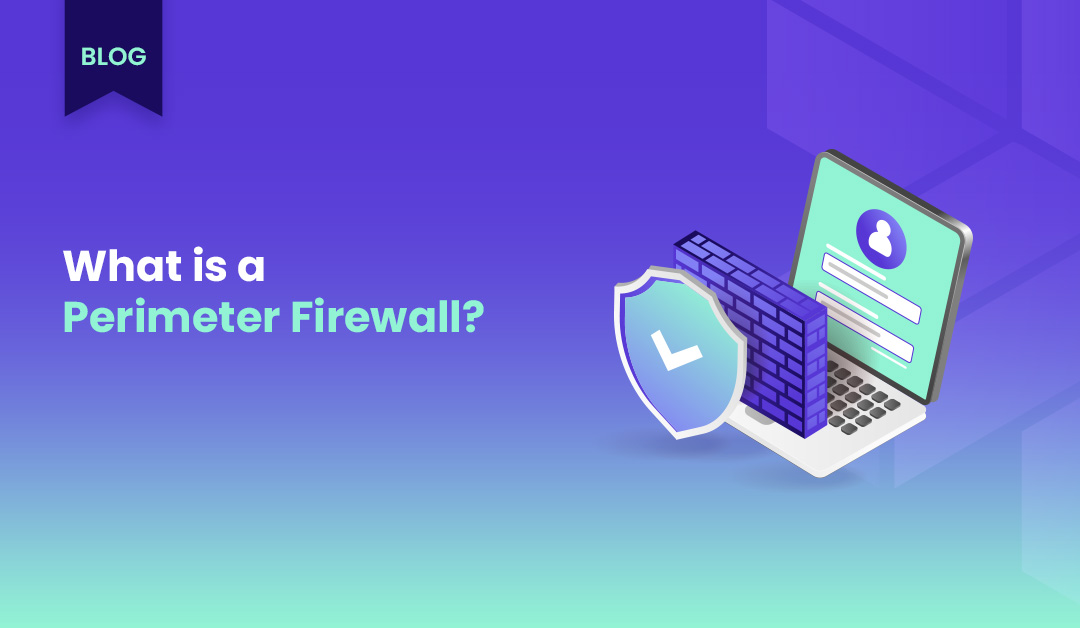Understanding Perimeter Firewall Fundamentals
Boundary firewalls act as the initial defense, a strong barrier between an internal private network and external, untrusted networks like the Internet. This extensive security response is vital in preventing unauthorized access and safeguarding confidential data from malicious individuals. What is a perimeter firewall? A perimeter firewall is a tool that protects a private network, like the […]
Author
Date
Category
All Categories
- AI-powered security
- Attacks & Threats
- Cybersecurity
- Hybrid Cloud
- Network
- Network Firewall
- Network Protection
- News
- Remote Workforce
- Security
- Zero Trust
Contents
Popular Posts
Product
Join the Newsletter

Boundary firewalls act as the initial defense, a strong barrier between an internal private network and external, untrusted networks like the Internet. This extensive security response is vital in preventing unauthorized access and safeguarding confidential data from malicious individuals.
What is a perimeter firewall?
A perimeter firewall is a tool that protects a private network, like the one in a company, from outsiders trying to get in, usually from the Internet. It checks and controls the data coming in and going out, following rules set up for security. These rules say which internet addresses are allowed, which types of data can go through, and which cannot. It stops bad stuff from getting in and keeps the important stuff safe.

How Does a Network Perimeter Firewall Work?
A perimeter firewall is a device for network security that carefully examines and filters both incoming and outgoing network traffic based on preset security policies and regulations. It acts as a guardian, thoroughly inspecting data packets and deciding whether to allow or block their passage through the network boundary.
The firewall’s decision-making process is guided by a group of regulations known as Access Control Lists (ACLs). These ACLs define conditions such as IP addresses, website names, protocols, ports, and even the contents of the data packets. By applying these regulations, the firewall efficiently stops unauthorized access attempts and potential online risks while letting valid traffic move smoothly.
Packet Filtering
One of the fundamental techniques employed by perimeter firewalls is packet filtering. This method involves inspecting the header information of each data packet that goes across the network perimeter. The firewall examines parameters like source and destination IP addresses, port numbers, and protocol types to determine whether the packet should be allowed or denied entry.
Stateful Inspection
Advanced firewalls utilize a method known as stateful inspection, which surpasses the mere examination of packet headers. This method keeps track of all outbound connections and their related states. When a response packet tries to access the network, the firewall checks its state table to determine if the packet matches a valid, previously established connection. If a match is identified, the packet is allowed; if not, it is rejected. This effectively halts unauthorized access attempts and minimizes potential threats such as IP spoofing or network scanning.
Proxy Services
Another common feature of perimeter firewalls is the integration of proxy services. In this scenario, the firewall acts as an intermediary between the internal network and external networks like the Internet. Instead of allowing direct connections, the proxy server initiates separate connections for the requesting client and the target resource. This indirect communication method obscures the internal network’s topology, making it more challenging for malicious actors to gather information or launch targeted attacks.
Exploring Perimeter Firewall Features
Perimeter firewalls offer comprehensive features to enhance network security and provide granular control over traffic flow. Some of the key features include:
Network Address Translation (NAT)
Network Address Translation (NAT) is a technique that maps multiple internal IP addresses to a single external IP address, effectively hiding the internal network structure from the outside world. This feature conserves public IP address space and adds an extra layer of security by obfuscating the internal network topology.
Virtual Private Network (VPN) Support
Many perimeter firewalls integrate Virtual Private Network (VPN) capabilities, enabling secure remote access to the internal network. VPNs establish encrypted tunnels over untrusted networks, ensuring the confidentiality and integrity of data transmitted between remote users or sites and the corporate network.
Intrusion Detection and Prevention Systems (IDS/IPS)
Advanced perimeter firewalls often incorporate Intrusion Detection Systems (IDS) and Intrusion Prevention Systems (IPS). These components monitor network traffic for suspicious patterns or known attack signatures. While an IDS alerts administrators to potential threats, an IPS takes proactive measures to mitigate or block detected attacks in real time.
Application Control
Modern perimeter firewalls offer granular application control capabilities, allowing organizations to define policies that govern the use of specific applications or protocols within the network. This feature enables organizations to enforce compliance with security policies and prevent the misuse of corporate resources.
Unified Threat Management (UTM)
Many next-generation firewalls (NGFWs) integrate multiple security functions into a single appliance, providing Unified Threat Management (UTM). In addition to traditional firewall capabilities, UTM solutions may include features like antivirus protection, web filtering, spam filtering, and advanced malware detection, offering a comprehensive security solution for organizations.
What are the benefits of a Perimeter Firewall?
Implementing a robust perimeter firewall offers many benefits to companies, including:
Network Protection: Perimeter firewalls serve as the first line of defense against external threats, safeguarding the internal network from unauthorized access attempts, malware, and cyberattacks originating from untrusted networks.
Traffic Control: Perimeter firewalls enable organizations to exercise granular control over the types of traffic permitted to enter or exit the network by enforcing predefined security policies and rules. This capability ensures compliance with regulatory requirements and organizational policies.
Network Segmentation: Perimeter firewalls can be configured to create segregated network zones, known as demilitarized zones (DMZs). These zones provide an additional layer of security for hosting publicly accessible resources such as web servers or email gateways.
Centralized Management: Many perimeter firewall solutions offer centralized management capabilities, allowing administrators to monitor and configure security policies across multiple network segments from a single interface, streamlining administration and ensuring consistent enforcement of security measures.
Logging and Reporting: Perimeter firewalls maintain comprehensive logs of network traffic and security events, enabling administrators to analyze traffic patterns, identify potential threats, and generate detailed reports for auditing and compliance purposes.
Scalability: As organizations grow and their network infrastructure expands, perimeter firewalls can be scaled to accommodate increasing traffic volumes and evolving security requirements, ensuring continued protection and efficient traffic management.

What are the risks of a Perimeter Firewall?
While perimeter firewalls provide a strong defense against external threats, they are not immune to risks and limitations. Some potential risks and challenges associated with perimeter firewalls include:
Internal Threats: Perimeter firewalls are primarily designed to protect against external threats from untrusted networks. However, they may need to be more effective in mitigating internal threats, such as malicious insiders or compromised devices within the network perimeter.
Configuration Complexity: Configuring and maintaining perimeter firewalls can be complex, especially in large or dynamic network environments. Improper configurations or mishandled rule changes can inadvertently introduce security vulnerabilities or disrupt legitimate network traffic.
Performance Impact: As network traffic volumes increase, perimeter firewalls may experience performance degradation, potentially leading to latency issues or dropped connections. Ensuring adequate hardware resources and implementing load-balancing strategies are crucial to maintaining optimal performance.
Evolving Threats: Cyber threats constantly evolve, and perimeter firewalls must be regularly updated with the latest security patches, signatures, and rules to remain effective against emerging attack vectors and vulnerabilities.
Lack of Visibility: While perimeter firewalls can monitor and control network traffic, they may not provide comprehensive visibility into the content or context of the data traversing the network. This limitation can hinder the detection of advanced threats or data exfiltration attempts.
Bypass Attempts: Determined attackers may attempt to bypass perimeter firewalls by exploiting vulnerabilities in other components of the network infrastructure, such as web applications, remote access services, or unpatched systems within the network perimeter.
To mitigate these risks, organizations should adopt a multi-layered security approach that combines perimeter firewalls with complementary security solutions, such as intrusion detection and prevention systems, web application firewalls, endpoint protection, and robust security awareness training for employees.
What is the purpose of perimeter security?
The primary purpose of perimeter security is to establish a well-defined boundary between an organization’s internal network and untrusted external networks, such as the Internet. Organizations can effectively control and monitor network traffic flow by implementing robust perimeter security measures, mitigating the risk of unauthorized access, data breaches, and cyber-attacks.
Perimeter security encompasses various components and technologies, with perimeter firewalls serving as the cornerstone of this defense strategy. The key objectives of perimeter security include:
Access Control: Perimeter security measures, such as firewalls and access control lists (ACLs), enable organizations to enforce strict policies governing who or what is allowed to access the internal network. This ensures that only authorized users, devices, and network traffic are granted entry while potential threats are denied.
Threat Prevention: By monitoring and filtering network traffic at the perimeter, security solutions like firewalls, intrusion prevention systems (IPS), and web application firewalls (WAFs) can detect and block various types of cyber threats, including malware, distributed denial-of-service (DDoS) attacks, and attempts to exploit vulnerabilities.
Data Protection: Perimeter security is crucial in safeguarding sensitive data by preventing unauthorized access and mitigating the risk of data exfiltration. Firewalls and other security measures can be configured to restrict the flow of sensitive information outside the network perimeter, ensuring compliance with data protection regulations and maintaining the confidentiality of proprietary information.
Network Segmentation: Perimeter security solutions often incorporate the ability to create segregated network zones, known as demilitarized zones (DMZs) or screened subnets. These isolated segments host publicly accessible resources, such as web servers or email gateways, providing an additional layer of protection for the internal network.
Visibility and Monitoring: Perimeter security solutions, including firewalls and intrusion detection systems (IDS), generate comprehensive logs and reports, enabling organizations to monitor network activity, identify potential threats, and respond promptly to security incidents.
Regulatory Compliance: Many industries and regulatory bodies mandate specific security measures and controls to protect sensitive data and critical infrastructure. Implementing robust perimeter security solutions can help organizations demonstrate compliance with these regulations and industry standards.
While perimeter security is essential, it should be integrated into a comprehensive, multi-layered security strategy encompassing various defense mechanisms, such as endpoint protection, data encryption, security awareness training, and incident response planning. By adopting a holistic approach to security, organizations can effectively mitigate risks and protect their networks, data, and assets from a wide range of cyber threats.
How Can Timus Networks Help You?
The Timus firewall sits in the cloud and intercepts all encrypted user traffic. Admins can create granular user-based policies to restrict network access to the business’s specific needs. Timus’ adaptive cloud firewall sets the (SW-defined) security perimeter to wherever the users might be accessing the data. It can assess the risk of a user’s access request based on credentials, user behavior, and the context of the request. In addition, it reduces MFA fatigue by enforcing MFA only when the threshold on the risk profile is exceeded. It also scales and adapts with each new user or endpoint addition.
Simplified Access and Monitoring
Timus serves as a central entry point to all company networks, providing a security buffer. After thorough user verification through ZTNA, users are directed to their destinations via IPSec tunnels, including on-prem firewalls. For clients without offices, the Timus cloud firewall can suffice without additional FW. It monitors security events and produces detailed reports for auditing and compliance.
The Cloud-Based Solution of Timus
As your business grows and network requirements evolve, the Timus solution can be delivered 100% cloud-based as a SaaS solution, fitting seamlessly with existing infrastructure without complicating future enhancements. Our high-availability configurations ensure uninterrupted network operations, minimizing downtime and ensuring business continuity.
FAQ
The network perimeter refers to the boundary separating an organization’s internal network from untrusted external networks, such as the Internet. It represents the outermost layer of defense, where security measures like perimeter firewalls, intrusion detection/prevention systems (IDS/IPS), and demilitarized zones (DMZs) are implemented to control and monitor network traffic flow.
While the terms “perimeter firewall” and “external firewall” are sometimes used interchangeably, there is a subtle difference in their connotations. A perimeter firewall specifically refers to a firewall deployed at the network perimeter, acting as the primary barrier between an internal network and external networks. On the other hand, an external firewall is a broader term encompassing any firewall positioned outside the internal network, including those deployed in cloud environments, remote offices, or other external locations. In essence, all perimeter firewalls are external firewalls, but not all external firewalls are necessarily perimeter firewalls.
No, a Web Application Firewall (WAF) is not a perimeter firewall, although it can be deployed with one. A WAF is a specialized security solution designed to protect web applications and APIs from various types of attacks, such as SQL injection, cross-site scripting (XSS), and other application-level vulnerabilities. While a perimeter firewall operates at the network level, inspecting and filtering network traffic based on predefined rules, a WAF operates at the application level, analyzing and filtering HTTP/HTTPS traffic to and from web applications. WAFs are often deployed as an additional layer of security, complementing the perimeter firewall and providing specialized protection for web-based assets.
A Demilitarized Zone (DMZ), also known as a screened subnet or perimeter network, is a separate network segment that resides between an organization’s internal network and the external, untrusted networks. It is designed to host publicly accessible resources, such as web servers, email gateways, or FTP servers while providing an additional layer of security for the internal network. DMZs are often implemented using multiple firewalls or screening routers, with one firewall separating the DMZ from the external network and another firewall separating the DMZ from the internal network. This configuration allows for granular control over traffic flow and access permissions, ensuring that even if a resource in the DMZ is compromised, the internal network remains protected. While a DMZ is not a perimeter firewall itself, it is an integral part of an organization’s perimeter security strategy. It works in tandem with perimeter firewalls and other security measures to enhance the overall defense against cyber threats.
Get Started with Timus
Zero Trust. Adaptive Cloud Firewall. Secure Remote Access. In one.
